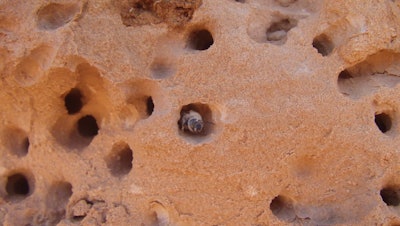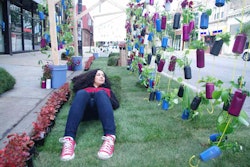 Anthophora pueblo chew through the sandstone to create their nests.
Anthophora pueblo chew through the sandstone to create their nests.Photo: Michael Orr, Utah State University
In the harsh environment of the desert, both flora and fauna develop peculiar adaptations to increase their chances of survival, and a recently rediscovered species of bees drills it way into sandstone to make its home.
Utah State University (USU) graduate student Michael Orr first encountered these tiny, gray bees at the Grand Staircase-Escalante National Park in Utah a year ago. When he discovered the nesting sites actually in the sandstone, he found a similar sample in the National Pollinating Insects Collection.
Retired USDA-ARS research entomologist Frank Parker had stumbled upon the sandstone-dwelling bees nearly 40 years ago in the San Rafael Desert. He had collected samples and raised the bees to emergence. The research was never published and the species was never formally identified.
Orr reached out to Parker and developed a plan to determine if the bees actually preferred this substance for their home. By targeting areas near water, which the bees used to help excavate the sandstone, he discovered nesting sites from Puebloan cliff dwellings at Colorado’s Mesa Verde to California’s Death Valley.
 A female Anthophora publo. Scale bar below is one-half millimeter.
A female Anthophora publo. Scale bar below is one-half millimeter.Photo: USDA
“Not much is known about this hard-to-find species and our first step was to confirm it actually prefers nesting in sandstone,” Orr told Phys.org. “Once we confirmed this preference, the next step was to explore why the bees expend such tremendous effort and energy, limiting their ability to reproduce, to create these shelters.”
The group of etymologists found that even though the drilling left significant wear and tear on the bees’ mandibles, the shelter protected them from erosion and sudden flash floods. The sturdy sandstone nests also made them less susceptible to parasites and dangerous microbes.
“Because sandstone contains less organic matter than typical soils, we expect more microbes that make their own food, such as photosynthetic cyanobacteria,” Orr said. “These microbes would be less likely to invade bee nests.”
The durable nature of the nests also allowed generations of the bees to inhabit the rock and expand the tunnels. Young bees also did not have to emerge right away, allowing them to wait for peak flower blooms.
“Delayed emergence is a bet-hedging strategy for avoiding years with poor floral resources – especially useful in the drought-prone desert,” Orr said.
Due to the bees’ presence at the Puebloan cliffs, the team decided to name the new species Anthophora pueblo.
“The desert is a hard place to live,” Orr said. “Anthophora pueblo has pioneered a suitable niche between a rock and a hard place.”










